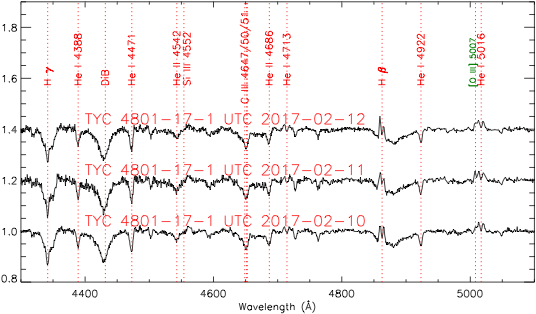Stars of spectral type Oe are very rare. To date, only 13 Oe stars have been identified within our Galaxy. Guang-Wei Li et al. of National Astronomical Observatories of Chinese Academy of Sciences (NAOC) discovered six new Oe stars, increasing the number of known Oe stars by nearly 50%, and four new B0e stars in Data Release 5(DR5) of Guoshoujing Telescope (LAMOST).
The O-type stars have temperatures higher than 30, 000 kelvin and show absorption lines of ionized helium. The Oe stars are the O-type stars with rapid rotating disks. As a result, there are double-peaked emission lines in their spectra.
Repeated spectroscopic observations of the same Oe stars show some emission line variability. The emission lines of star TYC 4801-17-1 show rapid variations, which have never been seen in other Oe stars. The bottom figure shows that the intensity of the left peak of the double-peaked emission line H keeps enhancing in three consecutive days from Feb. 10, 2017 to Feb. 12, 2017 in Coordinated Universal Time (UTC). At the same time, the forbidden line [O III] 5007 also varies, which implies that the tenuous matter around the star are also variable.
The unusual O4.5 star RL 128 is also an Oe star with variable emission intensity of the H line and its Ca II triplet emission appears when the emission of Hα reaches maximum intensity.
In our Galaxy, the Oe/O ratio is about 3%. For comparison, the Oe/O ratio of Small Magellanic Cloud (SMC) is about 26%, because the abundance of elements that are heavier than helium in SMC is much lower than that in the Galaxy. However, we still do not exactly know the origin of the Oe phenomenon. Indeed, Oe stars are a minority among O stars with emission lines. There are the other types of O stars with emission lines: Ofc, Onfp, Of?p, early Of/WN, and O Iafpe. Thanks to huge spectroscopic data from LAMOST DR5, we can discover so many new Oe stars. These newly identified early type Oe stars significantly increase the known sample and can undoubtedly help us understand their origins and natures in future.
Recently, this work has been published online in the world-renowned astronomical journal of Astrophysical Journal

Figure 1. Three spectra from Feb. 10, 2017 to Feb. 12, 2017 (UTC) are shown. The intensity of the left peak of the double-peaked emission line H keeps enhancing in these three consecutive days. At the same time, the forbidden line [O III] 5007 also varies during these three days.

Address: 20A Datun Road, Chaoyang District, Beijing, China code: 100012
Tel: 010-64888708 E-mail: naoc@nao.cas.cn

